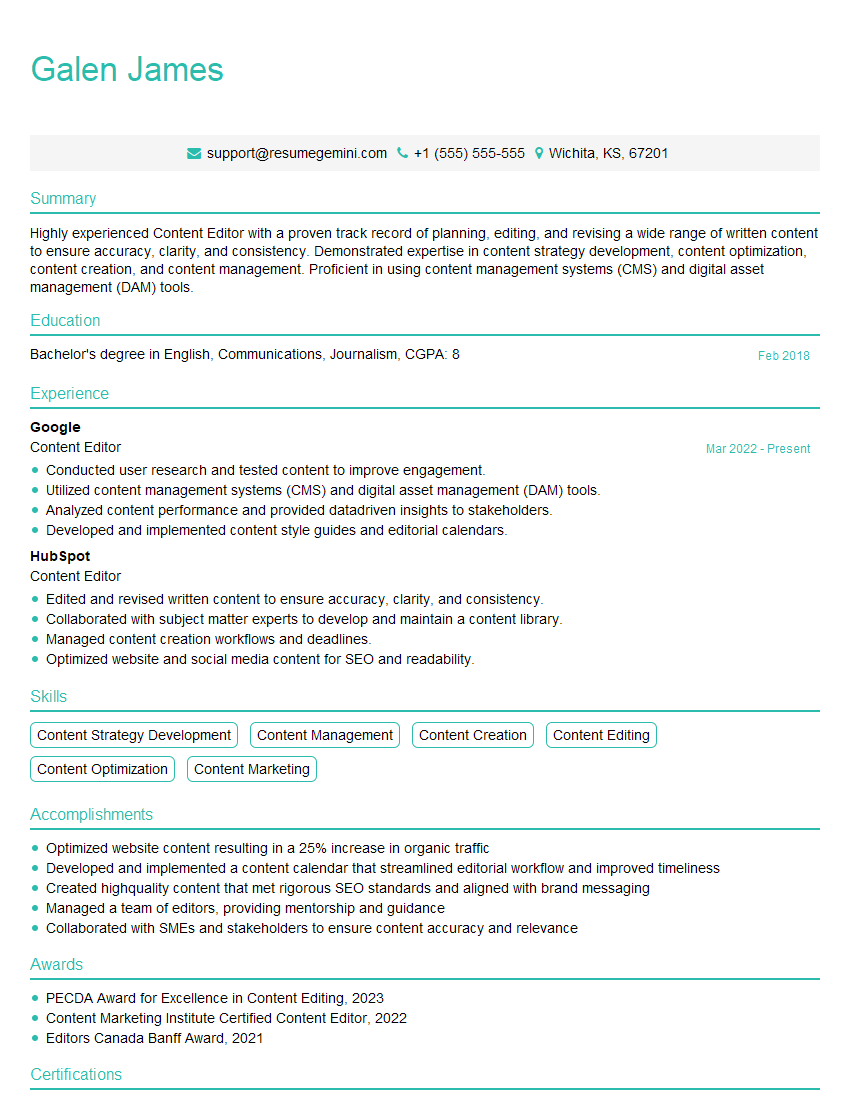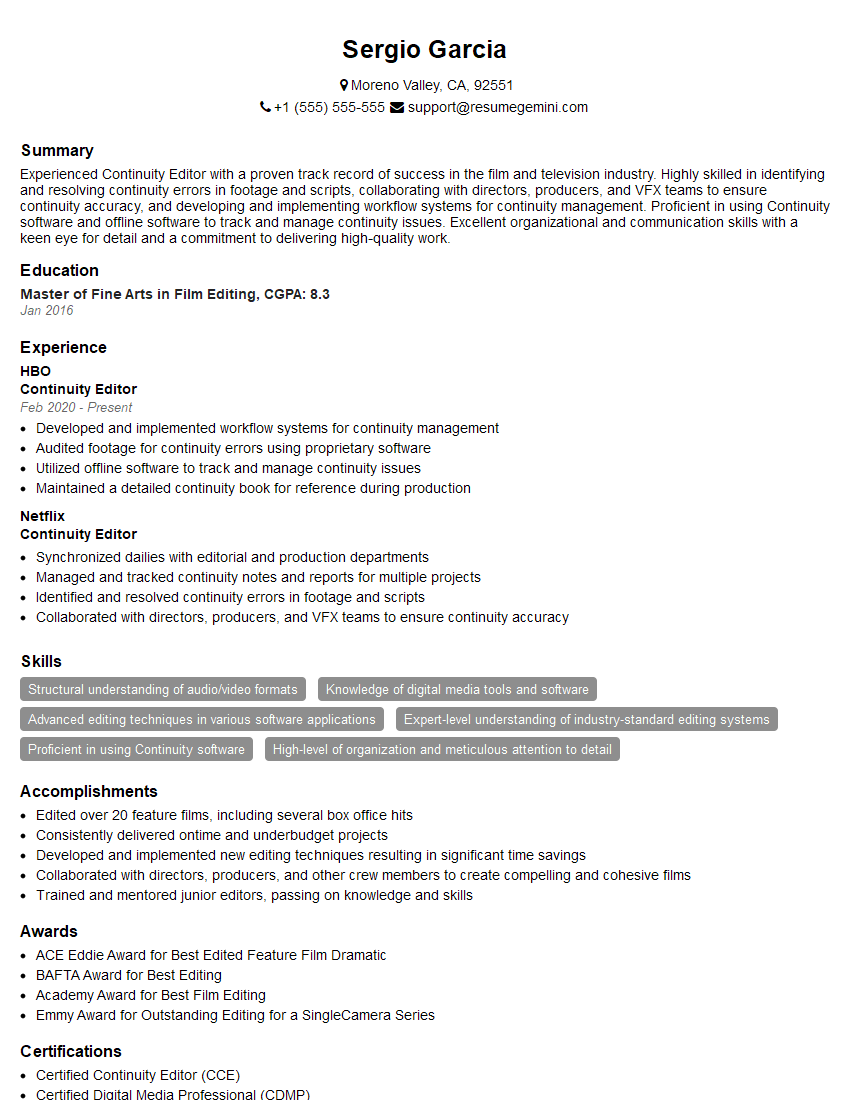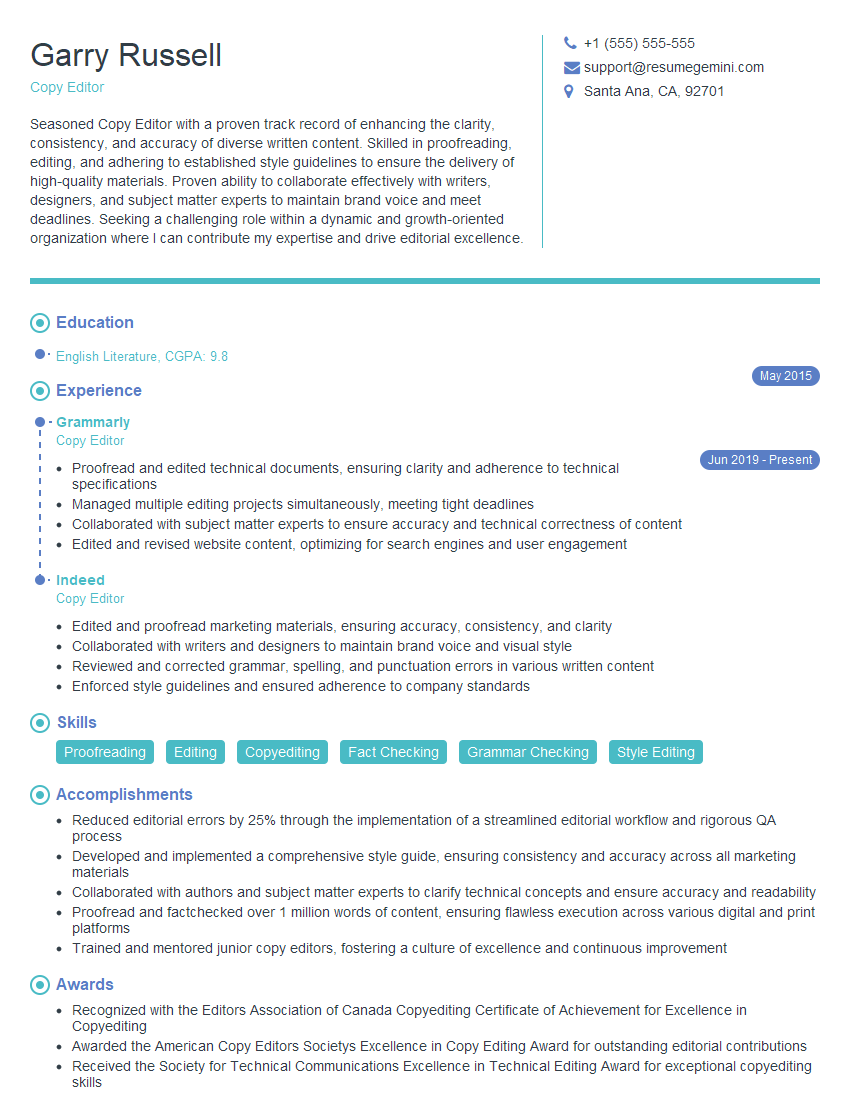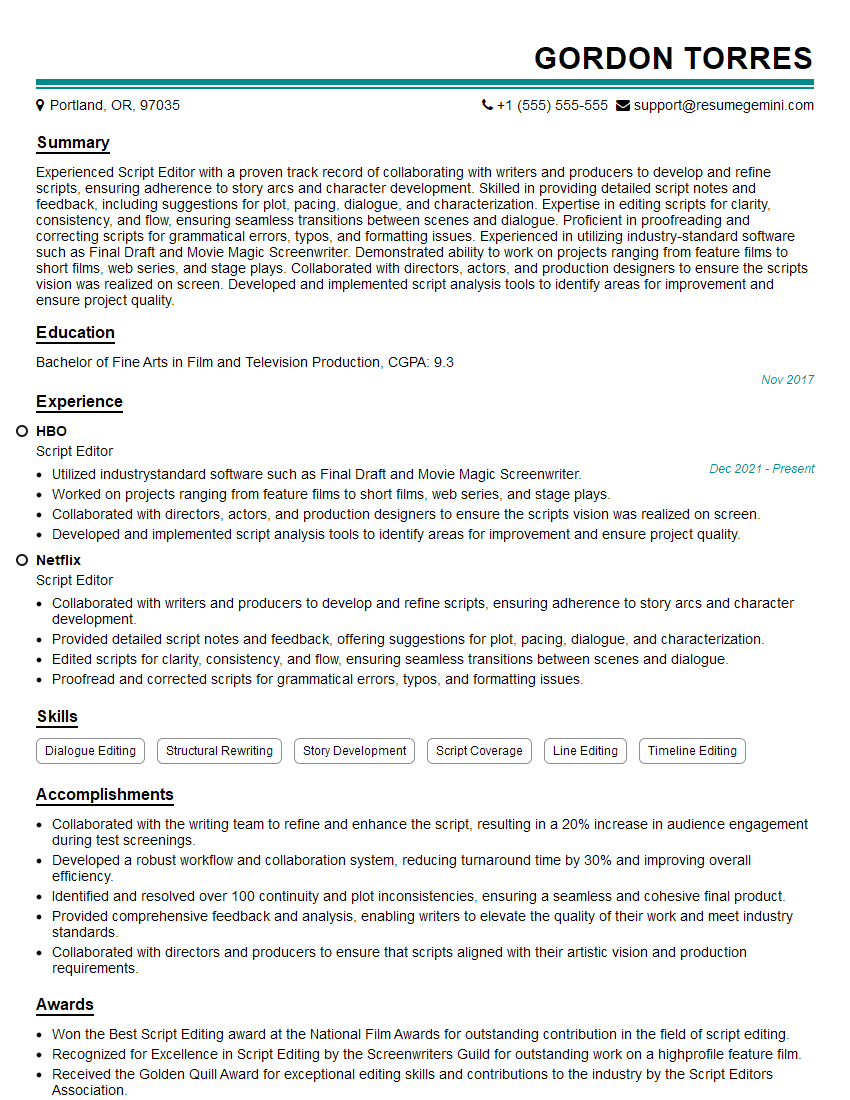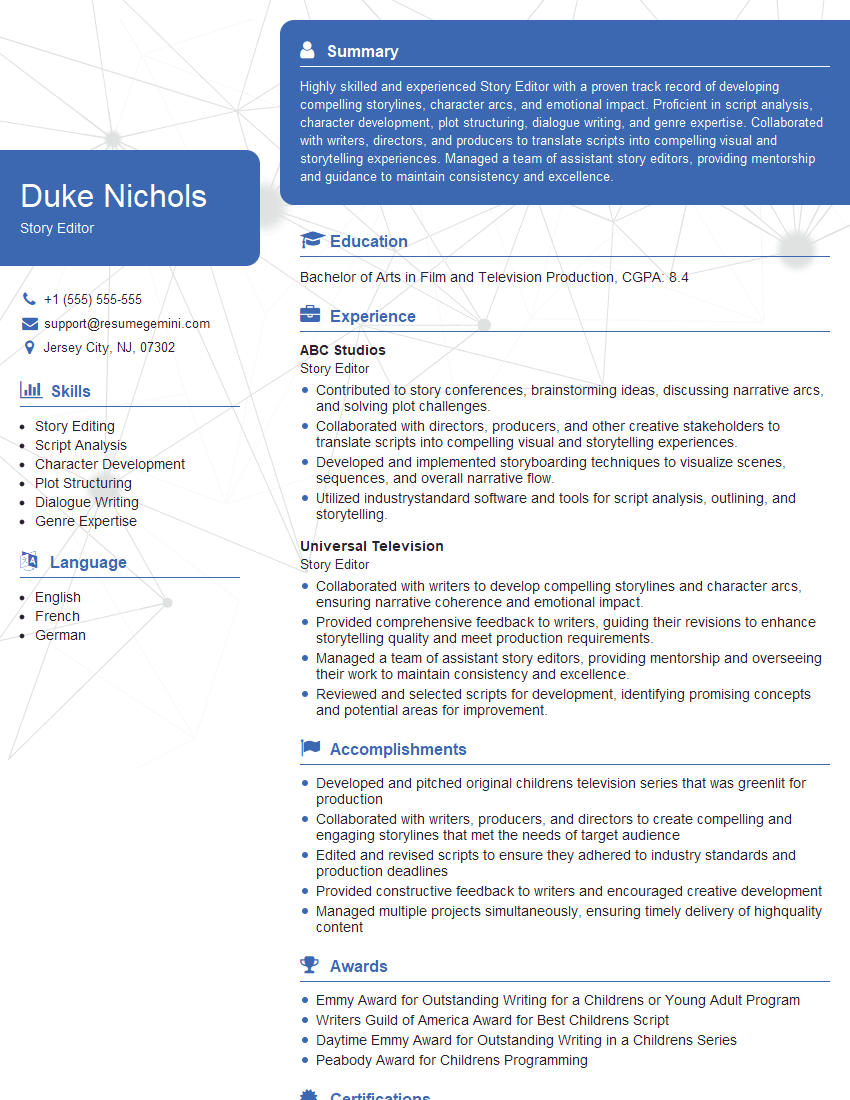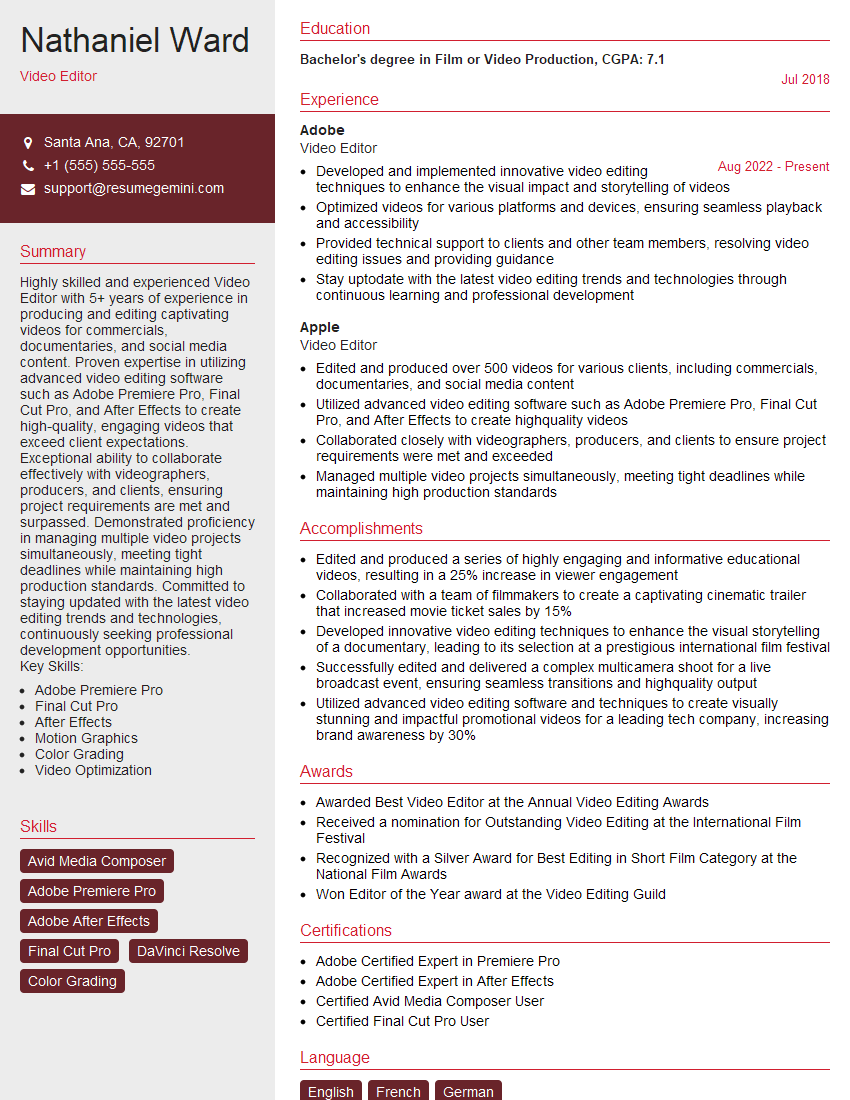Are you ready to stand out in your next interview? Understanding and preparing for Revising and Refining Scripts interview questions is a game-changer. In this blog, we’ve compiled key questions and expert advice to help you showcase your skills with confidence and precision. Let’s get started on your journey to acing the interview.
Questions Asked in Revising and Refining Scripts Interview
Q 1. Explain your process for identifying and correcting continuity errors in a script.
Identifying and correcting continuity errors is crucial for maintaining a script’s believability. My process involves a multi-stage approach. First, I meticulously read through the entire script, creating a detailed timeline of events, character actions, and setting details. This helps me visualize the narrative flow and spot inconsistencies. Second, I use color-coding or annotation tools to highlight potential issues like discrepancies in character descriptions, object placement, or timeline jumps. For example, if a character is described as wearing a red dress in one scene and a blue dress in the next, I mark this as a continuity error. Third, I systematically review the script, checking for consistency in these details. I often use a spreadsheet to track character attributes, locations, and objects to aid in identification. Finally, I carefully revise the script to resolve these inconsistencies, ensuring that the story remains logically coherent. It’s like solving a puzzle – ensuring every piece fits perfectly together.
Q 2. How do you handle conflicting feedback from multiple stakeholders on a script?
Handling conflicting feedback requires diplomacy and a strong understanding of the script’s overall goals. I start by carefully reviewing all feedback, categorizing it based on the area of concern (e.g., pacing, character development, plot). I then look for common threads or underlying issues. Often, conflicting feedback points to a deeper problem that needs addressing. For example, one stakeholder might want more action, while another wants more character development. This might indicate a problem with the balance between plot and character arc. I then try to synthesize the feedback, creating a revised script that addresses the core concerns. If compromises are necessary, I clearly explain my reasoning to all stakeholders, ensuring everyone understands the changes and their rationale. The goal is not to please everyone, but to create the best possible script based on informed decisions. I might even schedule a meeting to facilitate open discussion and collaboration among stakeholders to reach a consensus.
Q 3. Describe your experience with different script formatting styles (e.g., screenplay, teleplay).
I’m proficient in various script formatting styles, including screenplay, teleplay, and stage play formats. Screenplays, for example, follow specific conventions for scene headings, action lines, dialogue, and character names. Teleplays, which are for television, often require additional information, such as camera angles and sound effects. Stage plays have their own unique structure, focusing on character interactions and set descriptions. My experience ensures that I can adapt to different formats quickly and accurately, ensuring the script is presented in a professional and readable manner. I’ve worked on projects ranging from short films utilizing simple screenplay formatting to complex television series requiring detailed teleplay conventions with specifications for visual effects and editing cues. This adaptability is a significant asset in my revision work.
Q 4. How do you ensure a script maintains its intended tone and style during revisions?
Maintaining consistent tone and style throughout revisions requires a keen eye for detail and a deep understanding of the script’s overall purpose. I begin by clearly defining the intended tone and style early in the process. This might involve creating a style guide or mood board. During revisions, I use this guide as a reference point, ensuring that all changes align with the established tone. For example, if the script is meant to be humorous, I ensure that revisions don’t introduce overly serious or dramatic elements. Likewise, if the script is meant to be suspenseful, I ensure the pacing and dialogue support that. I also look for inconsistencies in word choice, sentence structure, and character voice to ensure everything remains cohesive. Imagine it as painting a picture; you need to maintain consistency in color palette and brush strokes to create a harmonious composition.
Q 5. What techniques do you use to improve the pacing and flow of a script?
Improving pacing and flow involves a combination of techniques. First, I identify areas where the narrative drags or feels rushed. This often involves analyzing scene length and the frequency of action beats. Then, I might employ techniques such as cutting unnecessary scenes or dialogue, adding subplots to provide texture and complexity, or rearranging scenes to create a more dynamic flow. For example, a slow-paced scene might be interspersed with a fast-paced action sequence to keep the audience engaged. I also analyze transitions between scenes, making sure they’re smooth and logical. Think of it like composing music; you need variations in tempo and rhythm to create an engaging and dynamic listening experience. I use tools like scene breakdown sheets and timelines to visualize the flow and make informed decisions about pacing.
Q 6. How do you identify and address dialogue that is unrealistic or unconvincing?
Unrealistic or unconvincing dialogue can derail a script’s credibility. I address this by first identifying the specific areas where dialogue feels unnatural. This might involve dialogue that is too formal, too informal, or simply doesn’t reflect the character’s personality or the situation. Then, I delve into understanding the context – the characters’ relationships, their motivations, and the setting. I rewrite dialogue to make it sound more authentic, reflecting the way real people speak in similar situations. This often involves using subtext, where unspoken feelings are conveyed through actions and pauses, rather than just explicit statements. I also consider the audience and their understanding of language to maintain clarity and relatability. Instead of saying ‘He was very angry,’ I might write, ‘His fists clenched, his jaw tight.’ This creates a more powerful and believable impact.
Q 7. What is your approach to rewriting scenes that are ineffective or lack impact?
Rewriting ineffective scenes requires a thorough understanding of what isn’t working. Is the scene too long? Does it lack a clear purpose? Are the characters’ actions unconvincing? My approach begins with identifying the core problem. Then, I consider various solutions. I might rewrite the scene completely, focusing on strengthening the conflict or raising the stakes. I might cut it entirely if it doesn’t contribute to the story. Alternatively, I might rearrange the scene, shifting events to create a more compelling narrative. Sometimes, a scene needs to be rebuilt entirely with a new approach, focusing on more dynamic character interactions or surprising plot developments. It’s like sculpting; you might need to remove parts or add new elements to reveal the final form. Throughout the rewriting process, I frequently review the overall arc of the story to ensure the scene remains relevant and contributes to the overall effect.
Q 8. How familiar are you with industry-standard script revision tracking software?
I’m highly proficient in various industry-standard script revision tracking software, including Final Draft, Celtx, and Adobe Story. My familiarity extends beyond simply using these tools; I understand their features for version control, collaborative annotation, and generating revision reports. For example, in Final Draft, I leverage its revision tracking effectively to maintain a clean history of changes, allowing for easy comparison between versions and quick access to specific revisions. This is crucial for managing feedback from multiple stakeholders, ensuring clarity, and preventing accidental overwriting of previous work. I also frequently use Celtx for its collaborative features, enabling real-time feedback and streamlining the revision process, especially in team-based projects.
Q 9. How do you balance creative input with the client’s vision when revising a script?
Balancing creative input with a client’s vision is a crucial aspect of script revision. I approach this as a collaborative process. First, I thoroughly understand the client’s objectives and target audience. Then, I analyze the script, identifying areas where the creative vision can be enhanced while staying true to the client’s core message. I might suggest alternative approaches, but always present them as options, clearly explaining their potential benefits and aligning them with the overarching goal. For example, if a client wants a more comedic tone, I would suggest specific dialogue adjustments or scene alterations, providing examples and explanations, rather than making sweeping changes without consultation. The key is open communication and iterative feedback – this ensures the final product meets both creative standards and client expectations.
Q 10. Explain how you maintain consistency in character voices and actions throughout a script.
Maintaining character consistency is paramount. I achieve this by creating detailed character profiles outlining their personalities, backstories, motivations, and speaking patterns. This serves as a reference throughout the revision process. I also use a color-coded system in my scripts (or software features if available) to highlight each character’s specific traits. This allows for quick identification of inconsistencies. For instance, if a character is usually reserved, I’d flag any scenes where they’re unexpectedly boisterous. This visual cue aids in catching discrepancies during revisions, ensuring the character remains believable and consistent throughout the narrative.
Q 11. How do you handle revisions that require significant structural changes to a script?
Handling significant structural changes requires a methodical approach. I wouldn’t simply start making changes haphazardly. My process begins with a thorough analysis of the script’s weaknesses, identifying the specific areas requiring restructuring. Then, I outline a revised structure, possibly creating a new outline or flowchart to visualize the changes. I would discuss this plan with the client or director, explaining the rationale behind each alteration. This ensures we are both on the same page before I start the actual rewrite. This is especially important when significant changes are involved, as it avoids wasted work and keeps everyone informed throughout the revision process. For example, if the climax needs to be moved, I’d plan how this shift impacts the pacing of the entire narrative and adjust accordingly.
Q 12. Describe your experience working under tight deadlines and pressure.
I thrive under pressure and have extensive experience meeting tight deadlines. I’m adept at prioritizing tasks, managing time effectively, and working efficiently under stress. For example, during a recent project where the deadline was unexpectedly moved up by a week, I reorganized my workflow, delegated some tasks (where possible), and maintained constant communication with the client to ensure all expectations were met. My ability to remain calm and organized, coupled with my strong organizational skills, enables me to deliver high-quality results even under intense time constraints.
Q 13. How do you ensure a script is both engaging and clear for its intended audience?
Creating an engaging and clear script hinges on understanding the target audience. I begin by carefully considering their age, cultural background, and existing knowledge. Then, I employ clear and concise language, avoiding jargon or overly complex sentences. Engaging elements such as strong character development, compelling storylines, and impactful dialogue are vital. For example, a script for children would need simpler vocabulary and a faster pace than one for adults. I ensure the script follows a logical narrative structure, using techniques like foreshadowing and cliffhangers to keep the audience hooked. Regular self-editing and seeking feedback are key to improving clarity and engagement before the script is finalized.
Q 14. What steps do you take to fact-check information presented within a script?
Fact-checking is an integral part of my process. I use a multi-layered approach. First, I identify all factual claims within the script. Then, I cross-reference this information using reputable sources like academic journals, established news organizations, and government websites. I maintain a detailed log of my sources for transparency and accountability. If discrepancies or uncertainties arise, I consult with experts in the relevant field to ensure accuracy. Finally, I meticulously review the fact-checked information before the final draft is submitted, ensuring all information presented in the script is accurate and verifiable.
Q 15. How proficient are you in various writing styles (e.g., comedic, dramatic, technical)?
My proficiency in various writing styles is a key strength. I’ve worked extensively with comedic scripts, crafting witty dialogue and ensuring consistent humor throughout. Dramatic scripts require a different approach, focusing on character development, emotional arcs, and building suspense. I’m equally comfortable with technical scripts, requiring precise language, clear explanations of complex processes, and attention to accuracy. For instance, I recently revised a comedic script for a sitcom, focusing on tightening the jokes and enhancing the pacing. A subsequent project involved a dramatic screenplay, where my focus was on strengthening the emotional core of the narrative and refining the character motivations. Finally, I’ve edited technical documentation for a software company, ensuring clarity and precision for a non-technical audience.
Think of it like playing different musical instruments; each style requires a unique set of skills and sensitivities, but the underlying principle of crafting a compelling narrative remains constant.
Career Expert Tips:
- Ace those interviews! Prepare effectively by reviewing the Top 50 Most Common Interview Questions on ResumeGemini.
- Navigate your job search with confidence! Explore a wide range of Career Tips on ResumeGemini. Learn about common challenges and recommendations to overcome them.
- Craft the perfect resume! Master the Art of Resume Writing with ResumeGemini’s guide. Showcase your unique qualifications and achievements effectively.
- Don’t miss out on holiday savings! Build your dream resume with ResumeGemini’s ATS optimized templates.
Q 16. How do you manage and prioritize multiple script revisions simultaneously?
Managing multiple script revisions simultaneously requires a structured approach. I use project management tools to track deadlines, assign priorities, and maintain clear communication with all stakeholders. I prioritize scripts based on urgency and impact, focusing first on those with the most immediate deadlines or highest potential impact. For instance, I might use a Kanban board to visualize the progress of each script, moving them through stages like ‘Initial Review,’ ‘Revisions in Progress,’ and ‘Final Review.’ This allows me to easily see which scripts need immediate attention and which are progressing smoothly. This methodology helps prevent bottlenecks and ensures timely delivery of high-quality work.
Q 17. What are some common mistakes you often encounter when reviewing scripts?
Common mistakes I encounter include pacing issues (scenes dragging or feeling rushed), weak character development (characters lacking depth or motivation), plot holes (inconsistencies in the storyline), and dialogue that feels unnatural or exposition-heavy. Another recurring problem is a lack of clarity in the narrative—the story’s message or the characters’ goals aren’t fully established.
For example, I often find scenes where excessive exposition dumps information on the audience instead of showing it through action and dialogue. Similarly, I frequently encounter underdeveloped supporting characters who serve only as plot devices instead of contributing to the overall narrative.
Q 18. Describe your approach to collaborating with other members of the script editing team.
Collaboration is central to effective script editing. I believe in open communication and a shared vision. I actively participate in brainstorming sessions, offering constructive feedback and actively listening to others’ ideas. I strive to create a collaborative environment where everyone feels comfortable expressing their thoughts and opinions. We use collaborative software to share notes, track changes, and maintain a unified vision. I always ensure that feedback is constructive, focusing on solutions rather than just criticism. This ensures a positive and productive working environment.
For example, in one project, we used a shared online document to track revisions, allowing all members of the team to see suggestions, approve changes, and provide feedback in real-time.
Q 19. Explain your understanding of the legal implications of copyright and plagiarism in script editing.
Copyright and plagiarism are crucial concerns in script editing. I understand that scripts are intellectual property protected under copyright law. Any unauthorized use or reproduction can lead to legal action. My work always involves verifying the originality of scripts, ensuring they don’t contain plagiarized material. I am familiar with various plagiarism detection tools and techniques. I also ensure that any changes made to a script respect the original author’s copyright and adhere to any licensing agreements in place.
For example, if I detect even a hint of plagiarism, I’ll immediately bring it to the attention of the client and discuss potential solutions, which may involve rewriting problematic sections or even recommending the client obtain proper licensing.
Q 20. How familiar are you with different types of script analysis tools?
I am familiar with several script analysis tools, including software that analyzes dialogue, character arcs, and plot structure. Some tools offer features for identifying clichés or repetitive phrases, while others provide insights into the emotional tone and pacing of the script. This helps in pinpointing areas that need improvement. I’m proficient in using these tools to identify potential issues and track revisions effectively. For example, I might use software to create a character arc graph, visually representing the development of a character throughout the script. This aids in quickly identifying any inconsistencies or areas needing further development. The specific tools I utilize depend on the project’s needs and the client’s preferences.
Q 21. How do you identify potential plot holes or inconsistencies in a script?
Identifying plot holes and inconsistencies requires careful reading and attention to detail. I approach this systematically, tracking character actions, motivations, and the timeline of events. I create detailed outlines and timelines to identify any contradictions or unexplained events. I pay close attention to cause-and-effect relationships within the narrative to ensure logical consistency. For example, if a character acquires a crucial piece of information, I’d check to see whether this information is used later in the story and how it affects their actions. Similarly, I’d ensure that character motivations remain consistent throughout the narrative. Any inconsistencies are then addressed through creative rewriting, which might involve adding new scenes, revising dialogue, or adjusting character motivations.
Q 22. Explain your approach to providing constructive criticism on a script.
My approach to providing constructive criticism on a script is multifaceted and focuses on building the writer’s confidence while achieving a polished final product. I prioritize a positive and collaborative environment. I begin by identifying the script’s strengths before addressing areas for improvement. This positive reinforcement sets a constructive tone. Then, I utilize a three-pronged approach:
- Macro-level analysis: Examining the overall plot structure, character arcs, and theme development. I look for inconsistencies, plot holes, or pacing issues.
- Micro-level analysis: Scrutinizing individual scenes, dialogue, and character interactions. I focus on clarity, conciseness, and emotional impact. For example, I might suggest tightening dialogue that feels wordy or revising scenes that lack emotional depth.
- Specific, actionable suggestions: Instead of simply stating ‘this scene is slow,’ I’ll offer concrete solutions like, ‘Consider cutting the first three lines of dialogue in this scene to enhance pacing, and focus on the character’s reaction to the news rather than their internal monologue.’ I always explain *why* I’m suggesting a change, focusing on the overall narrative impact.
Finally, I always end with positive feedback, re-emphasizing the strengths of the script and the writer’s talent. It’s about fostering growth, not just fixing flaws.
Q 23. How would you address a scene that is too long or drags on for too long?
Addressing scenes that drag often involves a delicate balance of preserving the intended emotional impact while streamlining the narrative. I’d begin by identifying the source of the problem. Is it excessive exposition? Redundant dialogue? A lack of action or conflict?
My strategy typically involves:
- Cutting unnecessary dialogue: Often, scenes are lengthy due to characters explaining things that are already clear. I’ll look for opportunities to streamline dialogue, conveying information more concisely through actions and subtext.
- Condensing descriptive passages: While vivid descriptions are crucial, excessive detail can slow down the pace. I’d find ways to convey the atmosphere and setting more efficiently.
- Adding conflict or raising stakes: A slow scene often lacks tension. By introducing conflict or raising the stakes for the characters, I can re-energize the scene and make it more compelling.
- Re-evaluating scene purpose: Sometimes, a long scene isn’t inherently flawed, but serves a less crucial function than initially perceived. Careful consideration of the scene’s purpose within the larger narrative can reveal opportunities for condensation or even removal.
For instance, if a long scene focuses on two characters having a conversation that establishes backstory, I might suggest showing that backstory through action rather than lengthy exposition – perhaps a flashback or a subtle visual cue.
Q 24. How do you handle feedback that you disagree with?
Handling feedback I disagree with requires diplomacy and professionalism. It’s crucial to remember that feedback, even when differing from my perspective, is valuable as it reveals different interpretations of the script. I wouldn’t dismiss feedback outright, but rather approach it with a willingness to understand the reasoning behind it.
My approach consists of:
- Active listening: I carefully listen to the feedback and try to understand the perspective of the person providing it. Asking clarifying questions is key: ‘Could you elaborate on why you felt this scene was ineffective?’
- Respectful dialogue: Even if I disagree, I express my appreciation for their input. I might explain my creative choices and reasoning, but avoid getting defensive.
- Finding common ground: Often, the disagreement stems from a difference in interpretation or emphasis. Finding common ground and finding a compromise can lead to a mutually agreeable solution.
- Documentation of changes: I’d clearly document the feedback, my response, and the resulting changes made to the script.
Ultimately, my goal is to produce the best possible script, even if that means compromising my initial vision in certain aspects.
Q 25. How do you stay up-to-date with current trends and best practices in scriptwriting and editing?
Staying current in scriptwriting and editing involves a multi-pronged approach. I actively engage with the industry through:
- Reading widely: I regularly read both successful and critically acclaimed screenplays to analyze different writing styles and techniques.
- Attending workshops and conferences: Industry events provide opportunities to learn from experienced professionals and network with peers.
- Following industry blogs and publications: Websites and publications dedicated to screenwriting offer insights into current trends and best practices.
- Analyzing successful films and TV shows: Observing the storytelling techniques and stylistic choices employed in popular media helps identify current trends.
- Mentorship and peer review: Collaborating with other writers and editors provides valuable feedback and insights.
For instance, currently, the trend towards character-driven narratives and inclusive representation heavily influences how I approach revisions. I actively seek out materials that explore these concepts.
Q 26. Describe your experience in adapting existing material into a new script format.
I have extensive experience adapting existing material into new script formats. This often involves careful consideration of the source material’s strengths and weaknesses, the target audience, and the desired tone and style of the new adaptation. The process typically involves:
- Analyzing the source material: This involves identifying the core themes, characters, and plot points that are essential to the story.
- Defining the target format: Understanding the specific requirements and conventions of the new format (e.g., feature film, television series, short film) is crucial.
- Structural adaptation: This may involve restructuring the narrative to fit the new format’s constraints. For example, a novel might require significant condensation and restructuring for a feature film adaptation.
- Character development: Characters might need to be refined or re-imagined to fit the new format and target audience.
- Dialogue adaptation: Dialogue may need to be rewritten to reflect the tone and style of the new format.
One particular project involved adapting a novel into a screenplay. The novel’s episodic structure didn’t translate well to the film format, so I condensed the plot, focused on the most pivotal character arcs, and streamlined the narrative, maintaining the core emotional beats while creating a satisfying cinematic experience.
Q 27. What is your understanding of the role of subtext in scriptwriting?
Subtext in scriptwriting refers to the unspoken or implied meaning that underlies the dialogue and action. It’s what the characters don’t say but communicate through their tone, body language, and actions. A strong understanding of subtext is crucial for creating nuanced and believable characters.
Subtext adds depth and complexity to a script, allowing for richer character development and more compelling storytelling. For example, a character saying ‘It’s fine’ in a flat tone while clenching their fists conveys a much different message than the literal meaning of the words. It suggests underlying anger or frustration.
I pay close attention to subtext during revisions, ensuring that the script’s implied meanings enhance rather than detract from the narrative. I often work with writers to explore subtextual layers that can add nuance and depth to their characters and plot.
Q 28. How do you ensure inclusivity and avoid stereotypes in your script revisions?
Ensuring inclusivity and avoiding stereotypes in script revisions requires careful consideration and a conscious effort to represent diverse characters authentically. My approach is guided by the principle of avoiding generalizations and presenting characters as individuals with their own unique experiences and complexities.
My strategies include:
- Research and consultation: I conduct thorough research to ensure accurate and respectful representation of diverse cultures and identities. This may include consulting with experts or individuals from the communities being depicted.
- Avoiding stereotypes: I actively avoid using stereotypical portrayals of characters based on race, gender, sexual orientation, disability, or other identifying factors.
- Creating well-rounded characters: Instead of relying on stereotypes, I create complex characters with unique personalities, motivations, and flaws.
- Diverse representation beyond tokenism: I ensure that diversity is not just superficial but integrated into the narrative and character relationships.
- Sensitivity reading: If possible, I involve sensitivity readers from relevant communities to review the script and provide valuable feedback on representation.
For example, instead of writing a character as a ‘typical angry black woman’ stereotype, I’d focus on creating a multi-layered character with individual motivations and struggles, avoiding broad generalizations and promoting genuine representation.
Key Topics to Learn for Revising and Refining Scripts Interview
- Understanding Script Structure: Analyze different script formats (e.g., screenplay, stage play, radio drama) and identify key elements like scene headings, action lines, dialogue, and character descriptions. Practice identifying strengths and weaknesses in script structure.
- Dialogue and Character Development: Evaluate the effectiveness of dialogue in conveying character personality, relationships, and plot points. Learn to suggest improvements for clarity, realism, and impact. Explore techniques for strengthening character arcs and motivations.
- Narrative and Pacing: Analyze the pacing of a script and identify areas where it may drag or feel rushed. Practice techniques for improving narrative flow, creating suspense, and building to a satisfying climax. Understand the impact of scene transitions and their role in maintaining narrative momentum.
- Subtext and Implication: Learn to identify and interpret subtext in dialogue and action. Practice suggesting revisions that enhance the implicit meaning and add layers of depth to the script. Explore how to create impactful scenes through implication rather than explicit exposition.
- Revision Strategies and Techniques: Explore various revision approaches, such as outlining, rewriting, and cutting. Learn how to provide constructive criticism and feedback on scripts, offering specific and actionable suggestions for improvement. Understand the iterative nature of the revision process.
- Collaboration and Communication: Discuss the importance of effective communication with writers and other collaborators during the revision process. Understand how to articulate your feedback clearly and professionally, offering solutions rather than just pointing out problems.
- Style and Tone: Analyze how style and tone contribute to the overall effect of a script. Practice identifying inconsistencies and suggesting revisions to achieve a consistent and appropriate tone throughout.
Next Steps
Mastering the art of revising and refining scripts significantly enhances your value as a collaborator and creative professional. It demonstrates critical thinking, communication, and attention to detail—skills highly sought after in various creative industries. To increase your job prospects, focus on building a strong, ATS-friendly resume that showcases these skills. ResumeGemini is a trusted resource to help you craft a professional and impactful resume that highlights your abilities. Examples of resumes tailored to Revising and Refining Scripts are available to help guide you in this process. Take this opportunity to showcase your talent and land your dream role!
Explore more articles
Users Rating of Our Blogs
Share Your Experience
We value your feedback! Please rate our content and share your thoughts (optional).
What Readers Say About Our Blog
Hi, I represent an SEO company that specialises in getting you AI citations and higher rankings on Google. I’d like to offer you a 100% free SEO audit for your website. Would you be interested?
Dear Sir/Madam,
Do you want to become a vendor/supplier/service provider of Delta Air Lines, Inc.? We are looking for a reliable, innovative and fair partner for 2025/2026 series tender projects, tasks and contracts. Kindly indicate your interest by requesting a pre-qualification questionnaire. With this information, we will analyze whether you meet the minimum requirements to collaborate with us.
Best regards,
Carey Richardson
V.P. – Corporate Audit and Enterprise Risk Management
Delta Air Lines Inc
Group Procurement & Contracts Center
1030 Delta Boulevard,
Atlanta, GA 30354-1989
United States
+1(470) 982-2456

